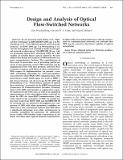| dc.contributor.author | Weichenberg, Guy Elli | |
| dc.contributor.author | Chan, Vincent W. S. | |
| dc.contributor.author | Medard, Muriel | |
| dc.date.accessioned | 2012-10-12T14:54:30Z | |
| dc.date.available | 2012-10-12T14:54:30Z | |
| dc.date.issued | 2009-07 | |
| dc.date.submitted | 2009-04 | |
| dc.identifier.issn | 1943-0620 | |
| dc.identifier.issn | 1943-0620 | |
| dc.identifier.uri | http://hdl.handle.net/1721.1/73922 | |
| dc.description.abstract | In our previous work [Chan, “Optical flow switching,” in BROADNETS 2006, pp. 1-8; Weichenberg, “Cost-efficient optical network architectures,” in ECOC 2006, pp. 1-2; Weichenberg, “On the throughput-cost tradeoff of multi-tiered optical network architectures,” GLOBECOM '06, pp. 1-6], we presented optical flow switching (OFS) as a key enabler of scalable future optical networks. We now address the design and analysis of OFS networks in a more comprehensive fashion. The contributions of this work, in particular, are in providing partial answers to the questions of how OFS networks can be implemented, how well they perform, and how their economics compare with those of other architectures. With respect to implementation, we present a sensible scheduling algorithm for inter-metropolitan-area-network (inter-MAN) OFS communication. Our performance study builds upon our work in IEEE J. Sel. Areas Commun., vol. 25, no. 6, pp. 84-101, 2007 and Weichenberg, “Performance analysis of optical flow switching,” presented at the IEEE International Conference on Communications, Dresden, Germany, June 14-18, 2009, and includes a comparative capacity analysis for the wide area, as well as an analytical approximation of the throughput-delay trade-off offered by OFS for inter-MAN communication. Last, with regard to the economics of OFS, we extend our previous work from ECOC 2006 and GLOBECOM '06 in carrying out an optimized throughput-cost comparison of OFS with other prominent candidate architectures. Our conclusions indicate that OFS offers a significant advantage over other architectures in economic scalability. In particular, for sufficiently heavy traffic, OFS handles large transactions at far lower cost than other optical network architectures. In light of the increasing importance of large transactions to communication networks, we conclude that OFS may be crucial to the future viability of optical networking. | en_US |
| dc.language.iso | en_US | |
| dc.publisher | Institute of Electrical and Electronics Engineers (IEEE) | en_US |
| dc.relation.isversionof | http://dx.doi.org/10.1364/JOCN.1.000B81 | en_US |
| dc.rights | Article is made available in accordance with the publisher's policy and may be subject to US copyright law. Please refer to the publisher's site for terms of use. | en_US |
| dc.source | IEEE | en_US |
| dc.title | Design and analysis of optical flow-switched networks | en_US |
| dc.type | Article | en_US |
| dc.identifier.citation | Weichenberg, Guy, Vincent W. Chan, and Muriel Médard. “Design and Analysis of Optical Flow-Switched Networks.” Journal of Optical Communications and Networking 1.3 (2009): B81. Copyright 2009 IEEE | en_US |
| dc.contributor.department | Massachusetts Institute of Technology. Department of Electrical Engineering and Computer Science | en_US |
| dc.contributor.department | Massachusetts Institute of Technology. Research Laboratory of Electronics | en_US |
| dc.contributor.mitauthor | Weichenberg, Guy Elli | |
| dc.contributor.mitauthor | Chan, Vincent W. S. | |
| dc.contributor.mitauthor | Medard, Muriel | |
| dc.relation.journal | Journal of Optical Communications and Networking | en_US |
| dc.eprint.version | Final published version | en_US |
| dc.type.uri | http://purl.org/eprint/type/JournalArticle | en_US |
| eprint.status | http://purl.org/eprint/status/PeerReviewed | en_US |
| dspace.orderedauthors | Weichenberg, Guy; Chan, Vincent W.; Médard, Muriel | en |
| dc.identifier.orcid | https://orcid.org/0000-0003-4059-407X | |
| dc.identifier.orcid | https://orcid.org/0000-0002-8274-6636 | |
| mit.license | PUBLISHER_POLICY | en_US |
| mit.metadata.status | Complete | |
